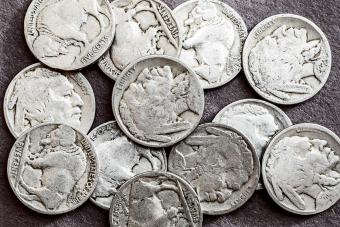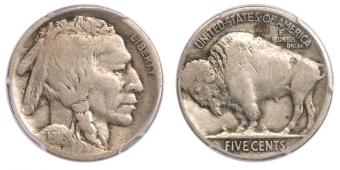
Nickels are the unsung heroes of American coins. Where would all of us be with our fast math skills without the most useful and divisible coin in our pockets? Out of luck, that's what. For how much they're overshadowed by specialty dollar coins and cool quarter designs, some old nickels pack a punch in the auction circuit. From thousands to millions of dollars, you don't want to pass up on finding any of these most valuable nickels.
Cheat Sheet for the Most Valuable Nickels
If you've heard anything about coin collecting, it's probably got to do with mercury dimes or Morgan dollars, and not the simple five cent coin that makes giving exact change a lot easier. Nickels were first issued in 1866, meaning that there's a whole 150+ years of them that just might be worth something. Thankfully, only a handful of historic nickels have catapulted to the top of the coin collecting world.
Next time you find yourself clearing out the loose change in your dryer or car, check to see if you've got any of these valuable nickels.
| Most Valuable Nickels | Estimated Value |
| 1913 Liberty Nickel | $4.2 million |
| 1926-S Buffalo Nickel | $50-$322,000 |
| 1916 Buffalo Nickel with Double Die Obverse | $3,000-$10,000 |
| 1877 Proof Shield Nickel | $2,000-$3,000 |
| 1918/7-D Buffalo Nickel | $1,000 |
1913 Liberty Nickel

The 1913 Liberty Nickels are the rarest nickels ever made because only five were minted. Edward Howland Robinson Green had a monopoly on all of them. Each has a quaint name: McDermott, Eliasberg, Norweb, Olsen, and Walton, the latter of which recently shook the auction world by selling for $4.2 million. All five 1913 Liberty Nickels are accounted for, so owning one is pretty far out of reach - but not impossible. After all, why bother dreaming if you're not going to dream big?
1926-S Buffalo Nickel

The first time you learned about American coins containing capital letters labeling the mints they came from, you probably sifted through the change you've been saving up to see what you've got. Most commonly, people find coins from Denver or Philadelphia, but San Francisco - particularly in the 1920s - was a special place for minting coins. While almost a million of these coins were made in San Francisco, finding them in the highest quality grades is rare. Thus far, the most one has ever sold for at auction was $322,000. Even lower grades frequently sell in the mid-thousands.
1916 Buffalo Nickel With Double Die Obverse

Die breaks are the most common way to turn an ordinary coin into a (potentially) extraordinary one. Basically, the metal mold with the image on it messes up when pressing the picture into the blank metal, resulting in little mistakes. The 1916 Buffalo nickel has a famous double die obverse mistake that has the '1916' stamped on top of itself twice. This created a cool 3D effect.
In the very best condition, these 1916 Buffalo nickels sell for about $5,000-$10,000. Even those in an average condition frequently sell for about $3,000.
1877 Proof Shield Nickel

Proof coins are high-quality mints with super crisp images; basically, they're special because they're really pretty. It's unusual for a coin to only be made in proof mints, but 'twas the case for the 1877 shield nickel. Only 900 of these were ever made, but thanks to some sneaky hands, a handful of these entered circulation. No one's sure how many have survived, but those that come to auction consistently sell for around $2,000-$3,000. So, there's still some hope that you'll stumble across one in the wild and end up a few thousand dollars richer.
1918/7-D Buffalo Nickel

Guess who's back...back again? The nineteen-teens weren't a great time for the U.S. mint if these nickel mistakes are anything to go by. Just two years after the 1916 double die obverse error, the nickel's dates were messed up again. The 1918 on the coin's front was struck with both a 7 and a 8, making the 8 in 1918 have a misshapen look. They're not the most valuable misprints ever, but those in the best condition will easily sell for around $1,000.
Collect Every Nickel Design Throughout History
While it might take some time to hunt down these rare and expensive nickels from the past, setting out to collect one of every type is a much easier, but still exciting, task. The further back in time you go, the harder it'll be to find them. But who isn't up for a good old-fashioned scavenger hunt?
Shield Nickel
Shield nickels were made from 1866-1883 and were designed by James B. Longacre. They're best-known for the lyre-shaped shield on the face that's surrounded by flora and the iconic 'In God We Trust' motto.
Liberty Head "V" Nickel
Definitely the most classically beautiful nickel design is the Liberty Head that replaced the shield nickel in 1883 and lasted until 1913. On the face, you'll find Charles Barber's vision of the goddess Liberty encircled by 13 stars. The reverse (tails) side is unique because it uses Roman numerals instead of Arabic numbers to label the coin worth five cents.
Buffalo Nickel
James Earle Fraser's design for the Buffalo nickel evokes a powerful and moving image of an indigenous American on the face and a standing buffalo on the reverse. Now known as buffalo nickels, these coins were minted from 1913-1938.
Jefferson Nickel
Compared to all the nickels that came before it, the contemporary Jefferson nickel isn't all that special. Launched in 1938, it's the coin we're all familiar with. Interestingly, Jefferson's portrait on the nickel has undergone a few redesigns over the years, with the most current printing showing Jefferson off center and facing the viewer.
What to Look for in American Nickels
Quarters might have been the big thing when we were kids, but there's so much other hidden treasure for you to find. Chances are, you probably toss all your coins into the nearest cup or bag when you get any change, never taking a second glance. You'd be surprised at the cool things you can find in that handful of change from your venti Starbucks order. But you don't have to be a coin collector to find the special coins, you just have to know what you're looking for.
- Die breaks - Die breaks of any kind result in visible scars, dents, misshapen images, and double printings. This is where you want to look closely at every part of your nickels to see if any of the words, numbers, or pictures have anything off about them.
- Brockage - If you find a coin that's got the same full-sized or partial image on the front and back, then you've found one with a brockage. Brockage coins were stamped with a coin that got caught in the die, which doesn't happen all that often, making them a rare thing to discover.
- Old dates - Nickels minted in the Reconstruction era (about 1866-early 1880s) are rare finds. They're special because they made their way across 100 years to you. So, if you stumble across any nickels that're really aged and dirty, take a damp toothbrush and try to coax off some of the grime to see just how old it might be.
Sometimes the Ordinary Can Be Extraordinary
Nickels might not have the coolest designs or the rarest reputations in the coin collecting world, but they hold their own against cultural titans like America's infamous state quarter. In the right condition, some historic nickels are worth thousands. So, next time you're out and about, extend your 'see a penny, pick it up' mentality to the next coolest coin in the bunch.







